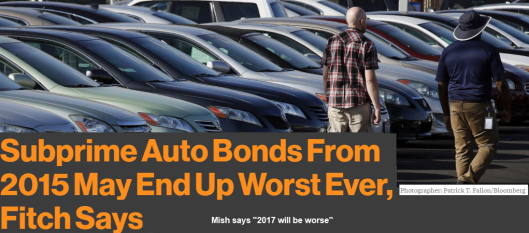Bloomberg reports Subprime Auto Bonds From 2015 May End Up Worst Ever, Fitch Says. I suggest 2017 will be worse, but let’s tune into Fitch first.

Subprime auto bonds issued in 2015 are by one key measure on track to become the worst performing in the history of car-loan securitizations, according to Fitch Ratings.
This group of securities is experiencing cumulative net losses at a rate projected to reach 15 percent, which is higher even than for bonds in the 2007, Fitch analysts Hylton Heard and John Bella Jr. wrote in a report Thursday.
“The 2015 vintage has been prone to high loss severity from a weaker wholesale market and little-to-no equity in loan contracts at default due to extended-term lending, a trend which was not as apparent in the recessionary vintages,” said the analysts, referring to lenders’ stretching out repayment terms on subprime loans, sometimes to over six years, to lower borrowers’ monthly payment. That becomes riskier in the tail end of the loan, after the car has mostly depreciated and borrowers may be left owing large balances.
Credit-rating companies that assess the auto debt packaged into bonds have raised concerns in recent months about rising delinquencies and defaults. They note that additional pressures in the used-car market have weighed on lenders’ ability to recoup funds from borrowers who have their cars repossessed.
S&P Global Ratings, which rates a larger percentage of the markets than Fitch and Moody’s, has blamed the rising net loss rates on weaker recoveries. S&P noted this month that net losses on prime deals have reached a pace not seen since 2008.
2017 Will Be Worse

2017 will be even worse. This Automotive News story provides an easy to understand explanation: New-Car Loans Lasting 73 to 84 Months Soar.
In the first quarter of 2009, 11.7 percent of new-vehicle loans were 73 to 84 months, Karl Kruppa, senior automotive solutions consultant for Experian, said at CU Direct’s Drive ’17 conference here last week. Through February 2017, 33.8 percent of loans were 73 to 84 months.
Even within that bucket, term lengths are creeping up. In the fourth quarter of 2010, three-quarters of new-vehicle loans in the 73- to 84-month category were between 73 and 75 months, Kruppa said. “Now we are seeing more and more lenders willing to go all the way up to 84 months,” he said. In the fourth quarter of 2010, 17.1 percent of new-vehicle loans were 84 months. In the fourth quarter of 2016, 28.7 percent of new-vehicle loans were 84 months.
“You know what’s kind of startling?” Kruppa said. “There’s actually 10 percent of [2010 model-year] used vehicles being financed at a term between 73 and 84 months. Longer terms are here, and more and more lenders are willing to do that.”












Leave A Comment